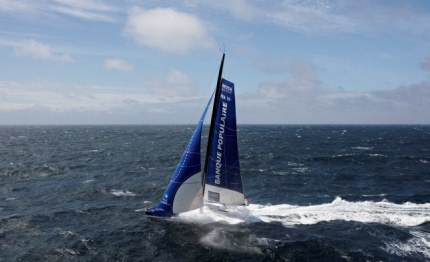VENDEE GLOBE
Vendée Globe: Cold Ahead Hot Behind

redazione
Whilst the rest of the fleet struggle to deal with either no wind or too much only the leader and Francois Gabart (Macif) and Armel Le Cléac’h (Banque Populaire) seem to be masters of their own universe. But even they will need to brace themselves for the cold to come as, 950 miles south of Australia, they dive down into the freezing Furious Fifties for the first time.
Jean-Pierre Dick (Virbac-Paprec 3), who appeared to have stemmed the losses of the previous 24 hours, in third place, reported the change on Saturday afternoon as he reached 48 degrees south.
"I'm 48 ° south and it's getting cold,” Dick said. “I had numbness in my fingers going on deck this morning. The cold pierces the bone. It’s about 5 ° C, the same for the water. The spray (shower) during the first light of day was chilly.”
"The good news is that the anticyclone will not catch me. It's good to get out of this windless mess. It was time."
Dick had lost 200 miles to the two in front but was making a far more healthy 14 knots at the 1600 ranking (French time). Le Cléac’h continues to average 18 knots with Gabart slowly drawing to 52.2 miles ahead by making consistently over 19 knots.
Sailing in winds that are suddenly jumping from 20 to 40 knots and messy seas, the two men, who both passed Cape Leeuwin on Friday night in record time, usually put their happiest spin on testing times, but on Saturday: "all is well in my boat, there have been beautiful sunsets" did not really cut it. Both admitted – in Gabart’s case only for the second time in the reace, that the relentless pace in difficult conditions was not coming easy. "It is exhausting," Le Cléac'h said. "The sea is bad, it’s not easy in these conditions," confessed Gabart. Although he couldn’t resist a: “I’m trying to show you the sunset I can see from here, it’s beautiful.” It could be that Gabard is preternaturally calm as well as proficient, or it could be that his mentor, Michel Desjoyeaux, the two-time Vendée winner, has taught him a thing or three about the psychology of demoralising your rivals. Either way it is working.
Two and a half thousand miles behind the leaders, Arnaud Boissières (Akena Verandas) had a bigger beat to wrestle and was having to be conservative as winds gusted up to 63 knots. “Right now I’m lying on the floor because I just can’t stand up on board,” Boissières said on Vendée Globe TV - whilst keeping a close eye on the conditions. “It’s shaking a lot. I haven’t been able to sleep that much, of course. I had 63-knot gusts! When that happens, the boat goes really fast (he reported 33 knots) but my average speed isn’t that high, though. I knew the front was coming, so I prepared for it, I slept last night and since then, I’ve only slept twice, half an hour each time.”
Javier Sansó (Acciona 100% EcoPowered) was making good speed but was also being pushed rather than pushing as he made up over 200 miles in 24 hours to Dominique Wavre (Mirabaud). Like Boissières, Sansó had big cross seas, with four metre swells coming from the north-west and south-west, but he had a more manageable is still ferocious 34-40 knots to deal with. Wavre, who was just 65 miles ahead of Sansó on Saturday afternoon, described his unusual encounter off Saint Paul Island.
Fleet News:
Like the grass which is always greener, in the Vendée the waves are always sweller on the other side and what Jean Le Cam (SynerCiel), who averaged just 4.1 knots in the fours hours after midday and Mike Golding (Gamesa), 5.8 knots, in sixth and seventh place, would do for such wind now.
They are stuck between the back and front, or the two weather fronts, of the fleet, bumping forward like men with their feet on the accelerator and the break. That someone of the brilliant routing ability of Le Cam is struggling too is some solace to Golding, or is at least keeping him sane. “I think Jean and I must have done something wrong in a former life to end up in this hole,” Golding, who was in fine form despite his travails, said.
“Having someone of the calibre of Jean gives you extra reassurance that you’re not doing too much wrong, it’s just the conditions around you.”
“It’s one thing having a lead but they (the two leaders) have actually made a real big jump here and I don’t think there’s anything anyone could have done about it, you just have to watch how quickly Hugo Boss and Virbac have fallen back.
“But there is still a realistic possibility of a podium, there’s still some attrition that could happen in the race and still changes that could occur. I mean in 204 I was five or six hundred miles behind at this point and I caught all of that and took the lead just after Cape Horn. So, it is absolutely possible to make a catch, but I’m afraid Francois and Armel have shown us a clean set of heels here.”
Read the full transcript of Golding’s fantastic video link to Vendée Globe TV, in which he compares and contrasts the speeds of the 2004-05 edition, in which he finished third, here and see it here.
Le Cam and Golding will have wind soon as the front roaring through Boissières and Sansó is coming their way.
Meanwhile, Alex Thomson (Hugo Boss), whose power problems mean he is not contactable for interview at the moment and Bernard Stamm (Cheminées Poujoulat) are finally in the stronger westerlies of what was Cyclone Claudia, after their complicated last couple of days in a transition zone, north-west of the leaders.
15/12/2012 19:37:00 © riproduzione riservata
Tweet
CORRELATI
DELLA SETTIMANA
50° Invernale del Tigullio: nel week end si conclude la prima manche
La rassegna velica a cura del Comitato Circoli Velici Tigullio vedrà svolgere, sabato e domenica prossimi, le ultime prove legate alla prima manche. Le previsioni meteorologiche parlano di vento di tramontana non particolarmente sostenute
Nautica: gli scenari di mercato secondo Confindustria Nautica
Confindustria Nautica, riunita nell’Assemblea annuale dei Soci, ha presentato l’analisi previsionale sull’andamento del settore, realizzata dall’Ufficio Studi dell’Associazione
San Foca: IV regata "Più Vela per Tutti"
Un mare affollato quello di ieri al largo di San Foca, grazie ad una bella giornata di sole e di vento ‘giusto’, anche per la flotta di ‘Più Vela Per Tutti’, che ha disputato la sua quarta regata del campionato invernale
50° Invernale del Tigullio: sorridono Spirit of Nerina, Sease e Ariarace
Spirit of Nerina (ORC A-B), Sease (ORC C) e Ariarace (Rating FIV). Sono questi gli equipaggi che festeggiano al termine della prima manche del 50° Campionato Invernale del Tigullio
Giovani campioni al vento: partito a Vilamoura lo Youth Sailing World Championships 2025
Dal 12 al 20 dicembre 2025 la Marina de Vilamoura, in Portogallo, è teatro dei Youth Sailing World Championships 2025, l’evento iridato giovanile che mette a confronto i migliori talenti velici under 19 di tutto il mondo
Invernale Napoli: vincone Raffica, Eurosia Pompa Pa’ e Sly Fox Cube
L’equipaggio di Orofino vince il Trofeo Gaetano Martinelli (ORC), quello di Neri e Cassese il Trofeo Oreste Albanesi (Sport Boat), mentre il team di Fotticchia conquista il Trofeo Paola Martinelli (Gran Crociera)
Jules Verne Trophy: The Famous Project CIC verso Buona Speranza
L'equipaggio capitanato da Alexia Barrier e Dee Caffari dopo un rallentamento per un guasto meccanico viaggia spedito verso il Capo di Buona Speranza
Napoli: oltre 100 barche in acqua per sostenere Telethon
Grande successo per il Trofeo Fondazione Telethon, la regata destinata a raccogliere fondi a favore della ricerca sulle malattie genetiche rare
Thailandia: una Regina in regata
Sua Maestà la Regina Suthida di Thailandia scenderà in acqua insieme al Team Thailandia per le regate della Star Sailors League
Trofeo Jules Verne: partito anche Thomas Coville
Sodebo Ultim 3, il maxi-trimarano francese guidato da Thomas Coville, è salpato il 15 dicembre 2025 per un nuovo tentativo di record sul Trofeo Jules Verne, il giro del mondo senza scalo né assistenza
